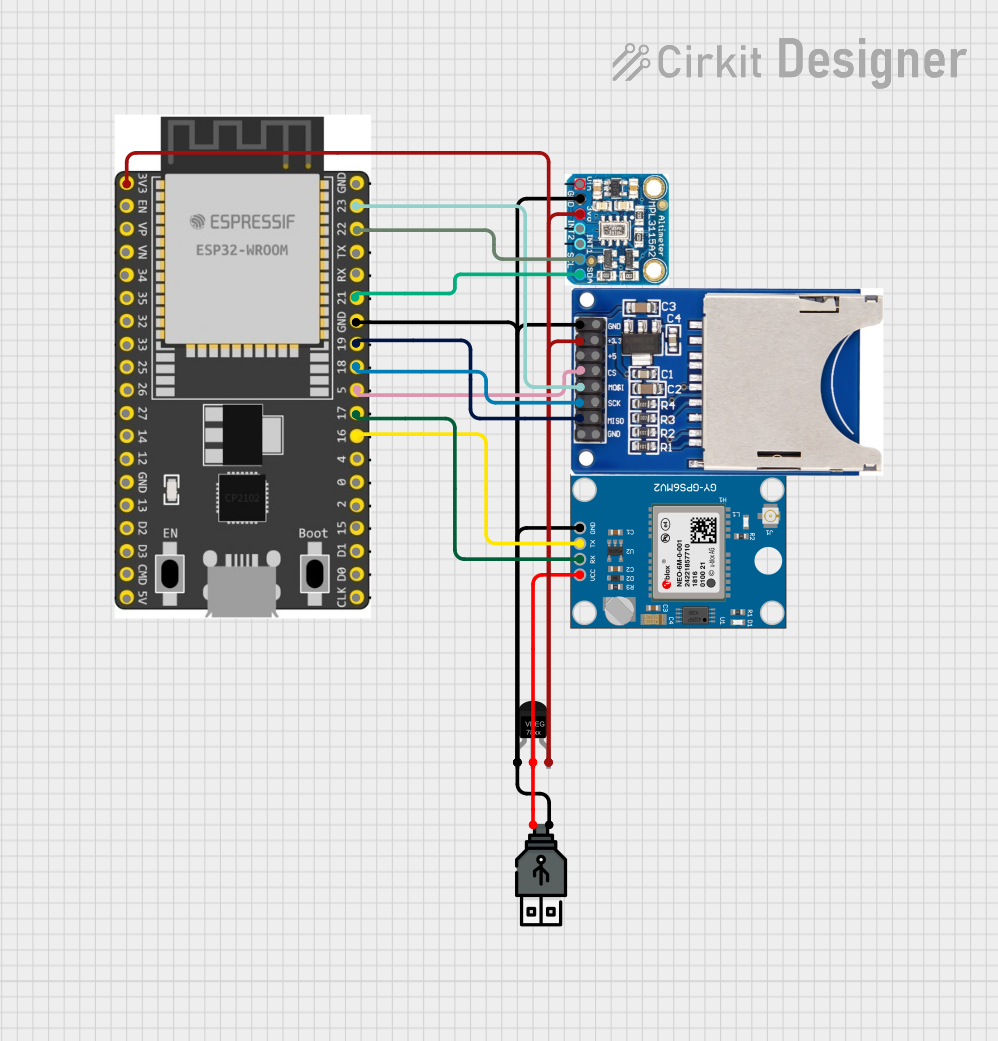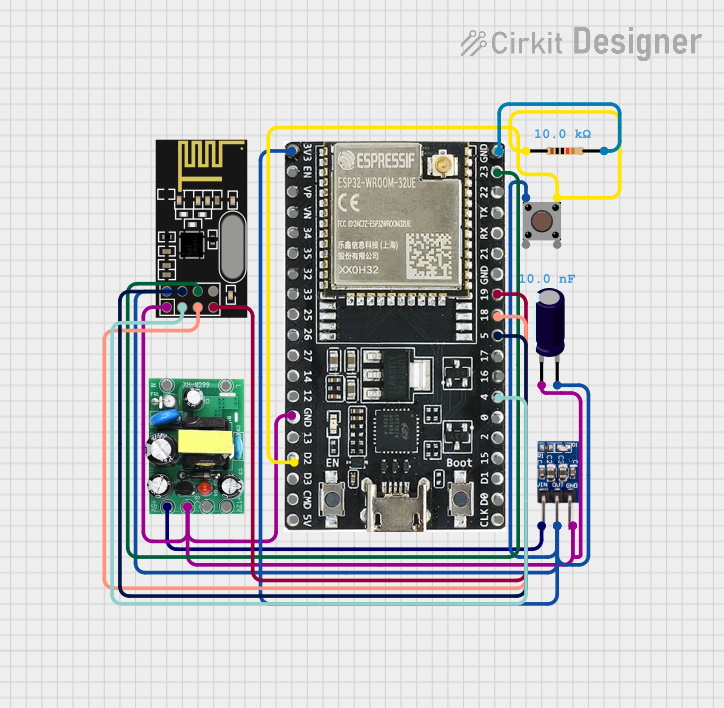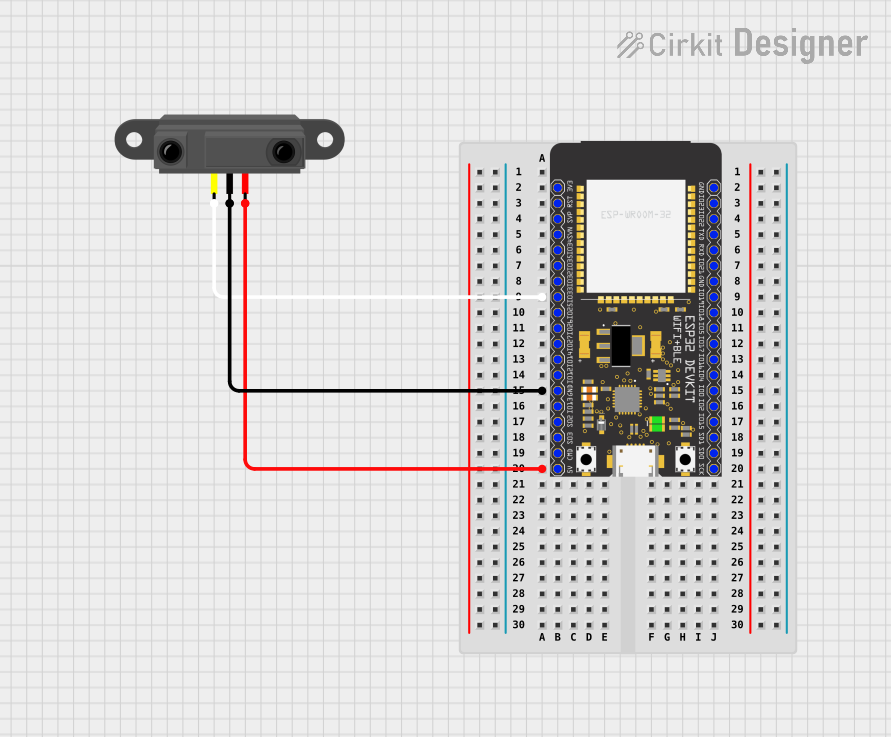
How to Use ESP-WROOM-32: Examples, Pinouts, and Specs

 Design with ESP-WROOM-32 in Cirkit Designer
Design with ESP-WROOM-32 in Cirkit DesignerIntroduction
The ESP-WROOM-32, manufactured by Wemos, is a powerful Wi-Fi and Bluetooth module based on the ESP32 chip. It is designed for Internet of Things (IoT) applications, offering dual-core processing, low power consumption, and a wide range of connectivity options. This module is highly versatile and suitable for a variety of projects, from home automation to industrial IoT systems.
Explore Projects Built with ESP-WROOM-32

 Open Project in Cirkit Designer
Open Project in Cirkit Designer
 Open Project in Cirkit Designer
Open Project in Cirkit Designer
 Open Project in Cirkit Designer
Open Project in Cirkit Designer
 Open Project in Cirkit Designer
Open Project in Cirkit DesignerExplore Projects Built with ESP-WROOM-32

 Open Project in Cirkit Designer
Open Project in Cirkit Designer
 Open Project in Cirkit Designer
Open Project in Cirkit Designer
 Open Project in Cirkit Designer
Open Project in Cirkit Designer
 Open Project in Cirkit Designer
Open Project in Cirkit DesignerCommon Applications and Use Cases
- IoT Devices: Smart home systems, environmental monitoring, and connected appliances.
- Wearable Technology: Fitness trackers and health monitoring devices.
- Wireless Communication: Wi-Fi and Bluetooth-enabled devices.
- Prototyping: Ideal for developers creating and testing IoT solutions.
- Industrial Automation: Remote monitoring and control systems.
Technical Specifications
The ESP-WROOM-32 module is built around the ESP32 chip, which integrates robust wireless communication capabilities and powerful processing features.
Key Technical Details
| Parameter | Value |
|---|---|
| Microcontroller | ESP32 (dual-core Xtensa® 32-bit LX6) |
| Clock Speed | Up to 240 MHz |
| Flash Memory | 4 MB (external SPI flash) |
| SRAM | 520 KB |
| Wi-Fi Standards | 802.11 b/g/n (2.4 GHz) |
| Bluetooth | Bluetooth v4.2 BR/EDR and BLE |
| Operating Voltage | 3.0V to 3.6V |
| GPIO Pins | 34 (multipurpose, including ADC, DAC, PWM, I2C, SPI, UART, etc.) |
| ADC Channels | 18 (12-bit resolution) |
| DAC Channels | 2 |
| Power Consumption | Ultra-low power consumption in deep sleep mode (~10 µA) |
| Operating Temperature | -40°C to +85°C |
| Dimensions | 18 mm x 25.5 mm |
Pin Configuration and Descriptions
The ESP-WROOM-32 module has multiple pins for various functionalities. Below is a summary of the key pins:
| Pin Name | Function | Description |
|---|---|---|
| 3V3 | Power Supply | 3.3V power input. |
| GND | Ground | Ground connection. |
| EN | Enable | Active-high pin to enable the module. |
| GPIO0 | Boot Mode/General Purpose I/O | Used for boot mode selection or as a GPIO pin. |
| GPIO2 | General Purpose I/O | Can be used as a GPIO or connected to peripherals. |
| GPIO16-39 | General Purpose I/O | Multipurpose pins for ADC, DAC, PWM, I2C, SPI, UART, etc. |
| TXD0/RXD0 | UART0 | Default UART pins for serial communication. |
| TXD1/RXD1 | UART1 | Secondary UART pins for serial communication. |
| ADC1/ADC2 | Analog-to-Digital Converter | 18 channels for analog input (12-bit resolution). |
| DAC1/DAC2 | Digital-to-Analog Converter | 2 channels for analog output. |
| IO34-39 | Input Only | GPIO pins that can only be used as inputs. |
Usage Instructions
The ESP-WROOM-32 module is easy to integrate into a variety of projects. Below are the steps and best practices for using it effectively.
How to Use the Component in a Circuit
- Power Supply: Connect the 3V3 pin to a stable 3.3V power source and GND to ground.
- Boot Mode: To upload code, connect GPIO0 to GND and reset the module. Disconnect GPIO0 from GND after uploading.
- Communication: Use the UART pins (TXD0/RXD0) for serial communication with a microcontroller or computer.
- Peripherals: Connect sensors, actuators, or other devices to the GPIO pins. Use ADC pins for analog input and DAC pins for analog output.
Important Considerations and Best Practices
- Voltage Levels: Ensure all connected devices operate at 3.3V logic levels to avoid damaging the module.
- Antenna Placement: Keep the onboard antenna clear of obstructions and metal objects for optimal Wi-Fi and Bluetooth performance.
- Power Supply: Use a low-noise, stable power source to prevent unexpected resets or malfunctions.
- Deep Sleep Mode: Utilize the deep sleep mode to conserve power in battery-operated projects.
Example: Connecting to an Arduino UNO
The ESP-WROOM-32 can be programmed using the Arduino IDE. Below is an example of how to connect the module to Wi-Fi and print the IP address.
Circuit Connections
| ESP-WROOM-32 Pin | Arduino UNO Pin |
|---|---|
| 3V3 | 3.3V |
| GND | GND |
| TXD0 | RX (Pin 0) |
| RXD0 | TX (Pin 1) |
Arduino Code
#include <WiFi.h> // Include the Wi-Fi library for ESP32
// Replace with your network credentials
const char* ssid = "Your_SSID";
const char* password = "Your_PASSWORD";
void setup() {
Serial.begin(115200); // Start serial communication at 115200 baud
delay(1000); // Wait for a second to stabilize
Serial.println("Connecting to Wi-Fi...");
WiFi.begin(ssid, password); // Connect to the Wi-Fi network
while (WiFi.status() != WL_CONNECTED) {
delay(500); // Wait for connection
Serial.print(".");
}
Serial.println("\nWi-Fi connected!");
Serial.print("IP Address: ");
Serial.println(WiFi.localIP()); // Print the module's IP address
}
void loop() {
// Add your main code here
}
Troubleshooting and FAQs
Common Issues and Solutions
Module Not Responding:
- Cause: Incorrect power supply or wiring.
- Solution: Ensure the module is powered with 3.3V and all connections are secure.
Wi-Fi Connection Fails:
- Cause: Incorrect SSID or password.
- Solution: Double-check the network credentials in your code.
Frequent Resets:
- Cause: Insufficient power supply or noise.
- Solution: Use a stable power source and add decoupling capacitors if necessary.
Upload Fails:
- Cause: GPIO0 not grounded during boot mode.
- Solution: Ensure GPIO0 is connected to GND before uploading code.
FAQs
Q: Can the ESP-WROOM-32 operate on 5V?
A: No, the module operates at 3.3V. Using 5V can damage the module.Q: How do I reset the module?
A: Pull the EN pin low momentarily to reset the module.Q: Can I use the ESP-WROOM-32 with Bluetooth and Wi-Fi simultaneously?
A: Yes, the ESP32 chip supports simultaneous use of Bluetooth and Wi-Fi.Q: What is the maximum range of the Wi-Fi connection?
A: The range depends on environmental factors but typically extends up to 100 meters in open space.
This documentation provides a comprehensive guide to using the ESP-WROOM-32 module effectively in your projects.